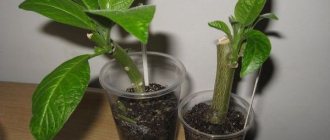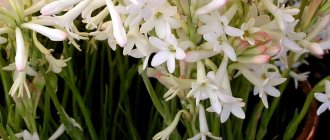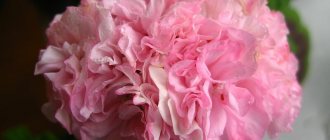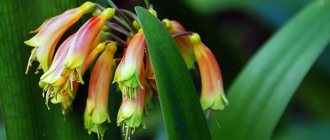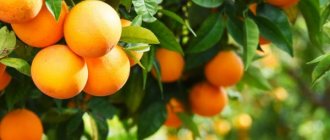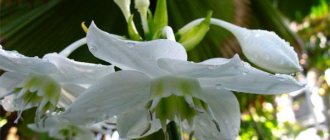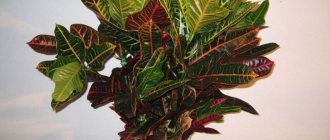In recent years, a beautiful plant, Brugmansia, has become popular. This is an original terrace flower that can be transplanted into open ground in summer. Its funnel-shaped flowers reach a length of 30 cm and smell wonderful. In summer, during one flowering period, it can produce several dozen flowers. In this article we will tell you how to grow Brugmansia - planting and care in the open ground and at home, how to ensure wintering, spring awakening, and provide a description of the varieties with photos.
Features of the external structure
During its growth and development, Brugmansia develops into a shrub or a small beautiful tree with a wide crown. The large leaves of the plant, arranged in tiers on the shoots, are ovoid in shape and can reach a length of 30 centimeters.
Depending on the species, the leaves may be pubescent. At the initial stage of development, up to 50-150 centimeters in height depending on the type of plant, Brugmansia grows with one trunk, after which it begins to branch.
The amazingly beautiful Brugmansia flower is a distinctive feature of the culture. Reaching 50 centimeters in length, the tubular-bell-shaped inflorescences acquired a second name due to their shape - “Angel Trumpets”.
The impressive color palette of Brugmansia flowers can range from white to orange, red or lilac with a variety of shades. During one summer flowering period, more than two dozen simple, double or two-tier flowers can bloom.
Speaking about the description of Brugmansia, one cannot fail to mention the characteristic very strong, but really pleasant aroma of flowers, which becomes more intense in the evening. From the beginning of summer to mid-autumn, the flowering of this plant lasts, ending with the ovary of fruits containing seeds.
It is practiced to grow Brugmansia outdoors in large pots and then move the flower indoors during the frost period.
It is important to remember that caring for the plant requires some caution, since all parts of it, especially the leaves and seeds, are poisonous. In this regard, it is recommended to carry out all manipulations with flowers using gloves.
Poisonous properties
Brugmansia is distinguished by its poisonous properties, due to which it can cause harm to human health. Therefore, it is important to wear gloves when working with it.
If the plant is grown at home or in the garden, you need to choose a place where none of the family members can accidentally touch it.
It is important to keep the flower away from small children and pets, to whom it is impossible to explain the danger of contact with this crop.
Even the slightest piece of grass that enters the body of a person or animal causes severe poisoning, even death.
The danger arises due to the fact that the plant contains toxic substances, namely atropine, scopolamine and hyoscyamine.
Brugmansia is a very poisonous plant
Brugmansia care rules
To obtain the desired result when planting and caring for Brugmansia outdoors, you need to take into account a number of nuances.
The main rule for planting a plant is to choose a good place, which for Brugmansia will be a sunny area of the garden. Of course, it can grow in the shade, but only in the open sun will the flowering be as impressive and long-lasting as possible.
When the sun is scorching, it is recommended to moisten Brugmansia leaves with warm water. Before planting, the soil must be fertilized and coarse sand added to it to achieve effective water permeability.
When growing in a pot or other container, you need to create a drainage layer at the bottom using expanded clay.
Preparing the soil for replanting
For replanting, it is recommended to prepare a nutritious and light soil layer, which must include:
- lowland peat;
- humus;
- garden soil.
If necessary, it is permissible to add a small amount of vermiculite, perlite and sand to the ground. To prevent the development of fungal infections, it is recommended to mix the soil with charcoal.
Since the plant grows quite quickly, the container should be large in volume. The procedure must be carried out in early spring, before the growth points awaken. Small shrubs need to be transplanted using the transshipment method into large containers.
Watering
Despite the fact that the plant tolerates hot weather well, it is extremely sensitive to lack of moisture and requires regular watering. In order for Brugmansia to feel good and please the owner, the soil must be constantly moist.
Otherwise, there is a risk that the plant will lose leaves and almost. Bushes growing in pots or other containers require daily watering. When the heat drops, you need to let the top layer of soil dry before watering.
Fertilizer and pruning
For active and healthy growth of the tree during the season, it is advisable to feed it every week. It is possible to use ready-made multicomponent baits, such as potassium-phosphorus fertilizers. If the volume of the container in which Brugmansia grows is 5 liters, you need to add 1 teaspoon of fertilizer during watering.
You can determine the lack of nutrients by the leaves that have begun to turn yellow and the discarded buds. You can stop intensive feeding at the beginning of autumn.
To give the required shape to the crown and control growth, it is possible to trim the branches of the tree. This should be done in the spring, before the start of the growing season. Also, with the help of pruning, it is possible to stimulate the flowering of the plant; to do this, you need to remove the shoots that have grown at the base of the trunk.
Winter care
The plant is extremely sensitive to frost, so it is advisable to grow it in containers so that the tree can be sheltered indoors during cold weather. With additional lighting indoors, Brugmansia can bloom for several months, but this can lead to a weakening of the plant as a whole.
The reason for this is that it is advisable to give the plant rest during the winter. To fully prepare for the season, the plant during the cold period should be kept at a temperature of 6-10 degrees and stand in partial shade.
At this time, the tree should be watered very sparingly, just not allowing the soil to dry out completely.
Angel Trumpet Flower and how to care for it?
Caring for Brugmansia is a rather complex process that includes the following steps:
- crown pruning;
- transplant;
- maintaining one temperature regime – from 23 to 28 degrees Celsius in summer;
- providing a cool winter;
- long-term diffused lighting;
- protection from drafts and sudden temperature changes;
- watering as the soil dries;
- maintaining a humid environment in the room and spraying;
- fertilizing once every 14 days with mineral fertilizers and organic matter.
Painless transplant
To successfully transplant Brugmansia, it must be done by transshipment, in early spring, at the moment when the root system has completely entwined the earthen ball. For soil, it is better to select universal mixtures enriched with peat and compost.
Do not forget about creating drainage; for this you need to pour a layer of expanded clay onto the bottom of the pot or hole. After planting, it is necessary to water the plant abundantly.
History of appearance
In ancient times, this plant attracted shamans and magicians to prepare tinctures and potions, which, in their opinion, had magical properties. Initially, Brugmansia belonged to the Datura genus; these potions and tinctures had an effect on the human body. It is not known for certain which particular variety of Brugmansia was discovered first.
Brugmansia - "angel's trumpets"
South America is considered the birthplace of the shrub. The Brugmansia flower was first mentioned by Branedba Kobo in the 50s of the 17th century. A description of the tree-like Brugmansia was mentioned by Louis Felluld in 1714. It received its current name at the beginning of the 18th century in honor of history teacher Sebald Brugmans.
Growing from seeds
Sowing seeds should be done at the end of winter or at the very beginning of spring, after soaking them in warm water for 24 hours. For sowing, it is ideal to use a sand-peat mixture, and plant the seeds to a depth of no more than 1 centimeter.
The container in which the seeds are sown must be covered with a transparent film. Shoots appear after 10-30 days, after which the film should be removed. Transplantation into the ground occurs after the appearance of 4-5 leaves.
Flower propagation methods
The plant propagates by seeds, cuttings and layering. The first two methods are the most popular.
Propagation by cuttings
Cuttings from the upper part of the plant, about 20 cm long, on which the apical growth point is located, are used as cuttings. It is also possible to cut cuttings from the side stems, but its development will take longer. The first flowering will occur a year later. The procedure is carried out from late spring and throughout the summer. The lower leaves are cut off from the prepared cuttings and the branches are placed in water, to which crushed activated carbon can be added. Glasses with blanks are placed in a bright, warm room. The roots appear very quickly, it will take a maximum of 2 weeks. You can plant them in separate containers when the roots have grown about 5 cm in length. Over the course of a month, they are regularly sprayed with a spray bottle, creating increased humidity; after this period, the flower finally takes root, and you can switch to the standard care regimen.
Rooting Brugmansia cuttings
Propagation by seeds
Brugmansia can be successfully sprouted from seeds at home. They are sown from early January to mid-March in nutritious loose soil and deepened by 5-10 mm. The soil is moistened, the container is covered with glass and polyethylene and sent to a warm room with bright, diffused light. The germination period depends on the freshness of the planting material and ranges from 1 to 6 weeks. As soon as the first shoots appear, the shelter is removed, and the young plants are regularly sprayed. Watering is carried out extremely carefully to prevent waterlogging. When the first 3-5 true leaves appear, the seedlings are transplanted to a permanent growing location. When the plants reach the age of 2 months, they begin to be fed with fertilizers containing nitrogen. After another couple of months, you can switch to complex feeding.
Important! When growing hybrid Brugmansia from seeds, you need to remember that varietal characteristics will not be passed on to the daughter plants.
Growing using cuttings
To propagate Brugmansia, you can use stem cuttings, which are best cut in May.
Young shoots with 3-4 internodes are ideal, with the lower foliage cut off and the upper foliage left in half. The resulting cuttings must be dipped in rooting hormone and only then immersed in a peat-perlite mixture to a depth of 3 centimeters.
It is advisable to cover the cuttings with a transparent bag and leave them in a well-lit place. You should not overdo it with watering, but the soil should be moist enough. Rooting of cuttings occurs on average after a month. The first flowering of a new plant occurs after 1-2 years


